This is a Konica F, a 35mm SLR produced by Konishiroku Photo Industries, Ltd in Tokyo, Japan in 1960. The Konica F was the very first 35mm Konica SLR and was a very ambitious camera with features never before seen on another 35mm SLR before. It was intended to compete with both the Nikon F and Canonflex professional cameras, released the year before. It features an all new vertically traveling focal plane shutter with a top 1/2000 shutter speed and 1/125 X-sync speed, a coupled selenium exposure meter with top plate read out, and interchangeable viewfinders. The camera also had a neat feature in which the film pressure plate would back off the film plane when advancing film through the camera to relieve friction on the film, allowing for smoother film transport, and then return to it’s original position when the film gets to the next exposure. The Konica F was a very nicely designed camera with an ambitious feature set, but it’s shutter proved to be unreliable and with an extremely high price, sold very poorly. The camera was discontinued shortly after it’s release and very few were ever made.
Film Type: 135 (35mm)
Lens: 52mm f/1.4 Konishiroku Hexanon coated 7-elements in 5-groups
Lens Mount: Konica F Bayonet
Focus: 2 feet / 0.6 meters to Infinity
Viewfinder: Interchangeable SLR Pentaprism, 0.93x Magnification
Shutter: Konishiroku Hi Synchro Vertically Traveling Metal Shutter
Speeds: B, 1 – 1/2000 seconds
Exposure Meter: Coupled Selenium Cell w/ top plate match needle
Battery: None
Flash Mount: Flash Clip w/ MX Synchronization, 1/125 X-Sync
Other Features: Self-Timer, DOF Preview, Interchangeable Viewfinder
Weight: 1134 grams, 858 grams (no lens), 718 grams (no viewfinder)
Manual: http://www.konica-collector.org/manuals/konica_f_man_cover.htm
How these ratings work |
The Konica F was the first Konica 35mm SLR and is a historically significant camera in that it was the first to feature a shutter of it’s type and a top 1/2000 shutter speed. The camera is very attractive and has some innovative features not found in other cameras, but it was an over ambitious camera that sold poorly and had poor reliability. As a result, very few were made and are extremely difficult to find today. Like all Konica cameras, it’s Hexanon lens is excellent, so despite some challenges in finding and using one, the images it makes are as good as those from any other camera out there. | ||||||
| Images | Handling | Features | Viewfinder | Feel & Beauty | History | Age | |
| 2 | 1 | 2 | 1 | 2 | 2 | 20% | |
| Bonus | none | ||||||
| Final Score | 12.0 | ||||||
History
The name Konica is used today in a variety of business applications, making products such as printers, photo copiers, and other imaging related technologies. The company that in 1965 produced the Konica F being reviewed today no longer exists, and as of 2006, exited the photographic and camera industry.

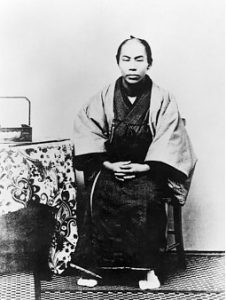
The original Konica had a long and prosperous history as the oldest Japanese camera maker. Konica could trace it’s roots all the way back to a man named Sugiura Rokusaburo who in 1873 sold pharmacy supplies in Tokyo, Japan. Sugiura launched his own pharmacy company, named Konishi Honten in 1878. In 1882, the company began producing it’s own photographic materials and selling them to other Japanese companies. Twenty years later, Konishi sold the Cherry Portable Camera, which was the very first Japanese made consumer camera.
Over the next 2 decades, Konishi Honten did very well, and in 1921 was renamed G.K. Konishiroku Honten. The company continued to be successful throughout the 1920s, releasing several other lines of cameras and even founded the Konishi College of Photography in 1923. In 1931, the company released the first ever commercially available Japanese camera lens, known as the Hexar.
Between the years of 1936 and 1943, as Japan became increasingly involved in World War II, the company’s business became reorganized and the name changed several times. At one point their entire retail and wholesale business was stopped.

After the war, the Japanese company hoped to expand their sales outside of Japan, so their name was changed once again to incorporate English, and now they were known as Konishiroku Photo Industry Co., Ltd. In 1947, the company released their first 35mm rangefinder camera, known simply as the “Konica”.
In the years after the war, many Japanese companies struggled to succeed outside of their home country as the world was not ready to put trust in Japanese made products but with Konishiroku’s strict attention to quality control and positive reputation, they eventually saw themselves at the forefront of the photographic world.
Throughout the 1950s, Konishiroku continually improved their 35mm models, even dabbling in other segments such as Twin Lens Reflexes like the Koniflex, and professional 6×7 medium format cameras like the Koni-Omega system, but like most camera makers, by the late 1950s demand was quickly growing for 35mm Single Lens Reflex cameras like the Japanese made Asahi Pentax and Miranda SLRs.
Little is known about the early development of the new Konshiroku SLR. In that era, SLRs made by similar Japanese companies often had a two to three year development cycle. In May 1959, Konishiroku would announce their new camera at the Tokyo International Trade Fair, which they called the Konica Flex. Assuming the typical development length, this means work likely began on the camera some time between mid 1956 and early 1957.
The new camera would have an ambitious list of features, including a coupled selenium exposure meter (behind a door on the front of the prism) with top plate match needle display, interchangeable pentaprism with a split image focus aide with Fresnel pattern for improved brightness, instant return mirror, automatic diaphragm, a metal focal plane shutter with speeds from 1 to 1/2000 and electronic flash synchronization at 1/125, a unique film pressure plate that relieves pressure off the film while advancing the film in an attempt to avoid scratching the film, self timer, and an all new bayonet lens mount with new Hexanon 7-element 50mm f/1.4 lens as standard.
Nine months later, in February 1960, the new SLR, now called the Konica F was released into production, retaining nearly all of the same features as the Konica Flex prototype with only two noticeable changes. The first was the removal of the hinged door over the selenium exposure meter and a slight revision to the standard f/1.4 lens, now measured as 52mm instead of 50mm.
The Konica F is a bit of a mystery as there are a lot of questions surrounding it’s release. It is unclear why the name of the camera was changed to Konica F. Some have theorized that the name change was to avoid confusion with the company’s Koniflex TLR, but a more likely explanation was to follow the trend of giving reflex cameras a name with “Flex” in the title.
Two “F” SLRs?: If you’re wondering why Konishiroku would release a camera called the Konica F with the same model name less than a year after Nippon Kogaku released the Nikon F, it is worth noting that when the first Nikon SLR was released, it was referred to as the Nikon Reflex. The letter “F” prominently located on the prism wasn’t originally part of it’s name. All Nippon Kogaku reference and marketing material simply used Nikon Reflex, meaning that the Konica F was the first “Japanese F SLR”.
The Konica F used a Konishiroku designed shutter that some sources online have falsely suggested was developed in cooperation with Copal. The Konica’s shutter is a completely unique design that was delicate, highly complex, and expensive to produce, and was one of the reasons the Konica F sold so poorly. Upon realizing that they could not build a line of consumer friendly SLRs using such a unique shutter, Konishiroku and a number of other Japanese companies jointly decided to work with Copal to come up with a simpler, cheaper, and more dependable design that would eventually be used in Konica’s next SLR, the Konica FS.
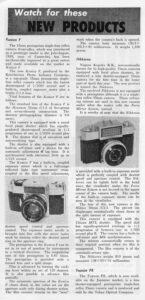
In the May/June 1960 issue of CamerArt magazine to the right, the Konica F was previewed to the magazine’s readers suggesting the camera had been “mechanically improved to a great extent” but does not clarify what exactly was improved. It gives little detail about the release of the camera, only summarizing the camera’s long list of features.

With a retail price in 1960 with case and 52mm f/1.4 lens of $395, which when adjusted for inflation compares to slightly over $4000 today, the camera was extraordinarily expensive, likely making it a tough sell to American photographers.
Perhaps realizing that the Konica F was too much camera for the market, in December 1960, a scaled down model called the Konica FS was released which eliminated the light meter, moving film plane, and had an improved, but simplified shutter with a top 1/1000 shutter speed. The camera was available in both chrome plated and black painted versions. Together with a 50mm f/2 Hexanon lens, the Konica FS sold for $189.95, less than half that of asking prices for the Konica F.
Production of the Konica F was short lived, and accurate sakes numbers were not kept, but the best estimates are that between 1500 to 1600 examples were made, a majority of which were exported to the United States. The camera still appeared in Konica’s 1961 Dealer Catalog with a reduced price of $379.95 suggesting it was available at least for a year before being quietly discontinued.
With poor sales of the flagship Konica F, by the time subsequent models like the FS, FP, and FM were released, the market for Japanese 35mm SLRs had become very crowded and Konica found itself struggling to keep up. The cameras and lenses were fine, but with so many options for consumers to choose from, Konishiroku knew that for their next SLR, they needed to try something different.
In 1966, the Konica Auto-Reflex would be released with an all new and much larger lens mount that was easier to mount and had a simpler aperture coupling system. Older Konica F-mount lenses could still be used on AR-mount Konicas with an adapter, but not the other way around. In addition to a new lens mount, the Auto-Reflex had a body mounted CdS exposure meter and for the first (and only) time in a 35mm SLR, supported both full and half frame exposures which could be switched mid roll. Typically, when a camera offered images in more than one size, it was via a mask in the film plane that needed to be added or removed without film in the camera.
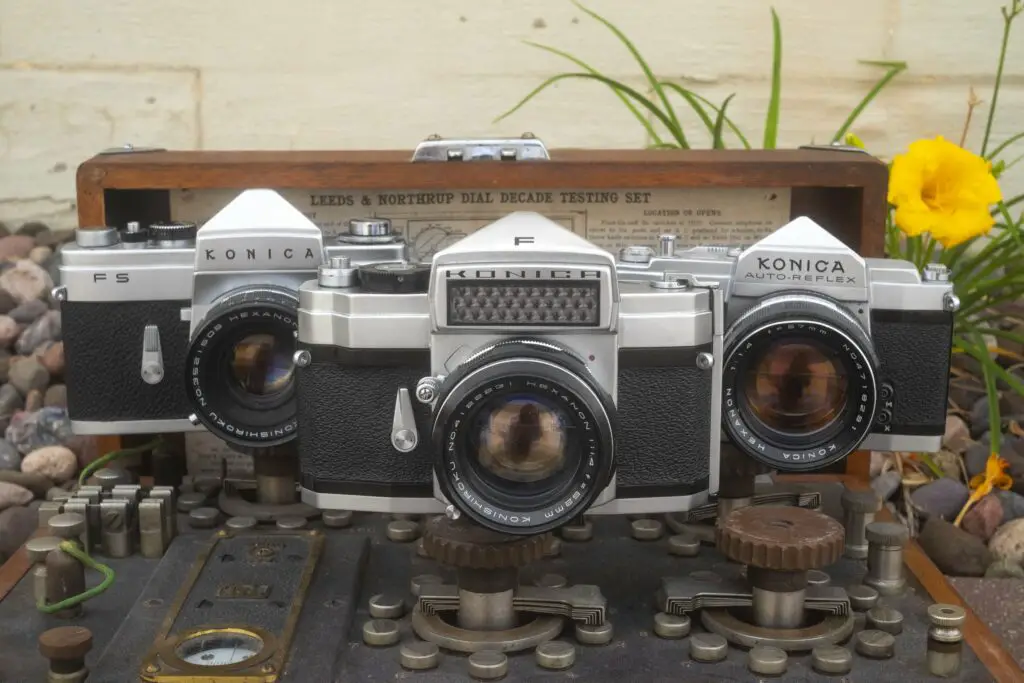
The new Auto-Reflex was a success, and spawned a whole series of later Autoreflex T-series cameras that featured TTL metering, but lost the full/half frame option. Konica would continue producing 35mm SLRs with the AR mount until the mid 1980s, at which time they exited the segment.
Today, Konica’s SLRs have a solid, but inconsistent reputation among collectors. Models like the Auto-Reflex and the early T-series cameras are generally well regarded with excellent lenses, but as Konica continued to stumble with their SLRs into the 80s, most of their later models are not desirable. The Konica F comes from a period in the Japanese photo industry where there was great innovation and excitement. No one yet knew who would be the leader of the industry or what features would become essential and the Konica F is a good example of an established company trying something new to see what would stick.
We have the benefit of hindsight to know that the camera wasn’t successful, but it certainly is pretty, and rare, and for that reason, is very collectible. The problem though is that with collectability and rarity, comes a higher price and in the rare instances where one of these cameras shows up for sale, prices are through the roof. Expect to pay several thousands of dollars if you want to buy one.
My Thoughts
I first learned of the existence of the Konica F when I was researching my review for the Auto-Reflex. At that time, my knowledge of the Japanese camera industry was that there was Nikon, and other than a brief attempt to compete with Canon’s original Canonflex, that no one had ever attempted to release a high quality professional level 35mm SLR.

When I found out that Konica had such a camera, I set my sights on one, but it didn’t take long to realize that the Konica F belongs in the category of unobtanium cameras. With less than 1500 made, it seems that all Konica Fs are already in permanent collections as they rarely show up for sale, and when they do, they fetch prices in the several thousands of dollars. Dismayed that I may never have a chance to write about, or even hold a Konica F, I settled for a Konica FS, a similar camera that uses the same Konica F Bayonet lens mount. The Konica FS proved to be an excellent shooter and I loved the images I got from it, but it was no Konica F.
With my fantasy of one day finding a Konica F on hold, fast forward to late winter 2023 when while researching a future episode of the Camerosity Podcast, I was introduced to collector, Ray Nason who is a mutual friend of Paul Rybolt. After talking to Ray, he shared images of a Konica F he had in his collection that he planned to sell. I contacted Ray and gave him my desperate plea to allow me the chance to give the camera a go before he sold it. He had told me that his plan was to bring it to a couple local camera shows and see if he could get any bites on it, and if it didn’t sell it, he’d send it my way.
The stars seemed to align and unfortunately for Ray, no one was interested in his camera, but fortunately for me, that meant I got a chance to borrow the camera for a while.
Ray sent the camera double boxed, triple bubble wrapped, and quadruple taped. When I removed it from it’s US Postal Service packaging, I was immediately stunned by both the camera’s beauty, and it’s weight. With the Hexanon 52mm f/1.4 lens mounted, the camera weighs an incredible 1134 grams. For comparison, my Nikon F2AS with prism and lens tips the scales at only 1048 grams and my Canon F-1 with lens is just a shy lighter at 1128 grams. Going through my collection of heavy 35mm cameras, the only one I was able to find that is heavier is the Zeiss-Ikon Contarex Bullseye with 50mm f/2 Planar lens at a beefy 1156 grams. This is a HEAVY camera.
Beyond the weight, the Konica F is stunning to look at. An elongated, bold Konica logo above the large selenium meter looks unlike any logo I’ve ever seen Konica use. I love the look, and can’t understand why this logo is only used on this one camera as I think it would have looked great on other cameras. The body has an asymmetrical top plate with angles and curves in places you don’t expect. The top of the prism starts out with a sharp and distinct point, but softly fades away into two gentle curves towards the back of the camera. The chrome is very smooth and appears to be very deep, much like a car with multiple coats of paint, giving a sense of quality. The body is covered in what looks like typical synthetic body covering, but the texture is deeply pebbled and feels great in the hand.
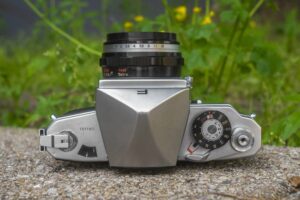
Up top, the Konica F has most of its controls in the locations you’d expect to see them, however their design is much different than other 35mm SLRs of the same era. Starting with the rewind lever, instead of a knob, the fold out handle is much smaller than a typical knob, and when not in use, folds neatly into the side flash bracket to keep it out of the way.
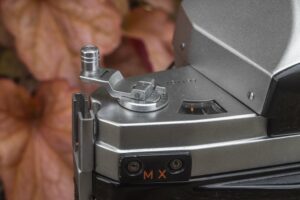
To the right of rewind handle is the selenium meter’s match needle display. Although a simple match needle, the Konica’s meter is coupled to the ASA film speed dial, shutter speed dial, and aperture ring. For 1960, this was quite advanced as many coupled meters of the era were coupled to only shutter speeds or aperture scale, but not always both. For as advanced as it was for the time, it’s operation is quite simple. A fixed triangular index mark stays in the middle of the display, and as you select different f/stops and shutter speeds, the meter needle will move in a corresponding direction to whatever setting you are using, and once the meter needle points to the index mark, you will have correct exposure.
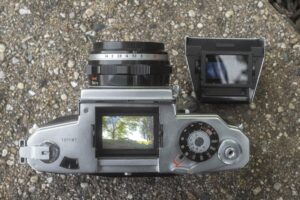
One of the highlight features of the Konica F is it’s interchangeable prism, which was a standard feature on professional level SLRs. A round button on the back of the camera below the eyepiece releases the prism and allows you to lift the prism off. According to the Konica F user manual, a waist level hood was available, but since the focusing screen remains inside the camera with the prism off, you could still use the camera at waist level without the hood, but you’d need to make extra effort to shield it from unwanted light. Compared to other SLRs with removable prisms, I prefer the kind that slide off the back as they feel more secure. The Konica’s prism comes off very easy, so be sure you have your hand supporting it when pressing the release button.
Although the prism is interchangeable, the focusing screens do not appear to be. I found no mention of different screens in the camera’s manual or in the literature I found about the camera. One last thing is with the prism removed, it does not look like any thought went into later supporting a metered prism. While the body already has a selenium cell, had the Konica F been a success and the company wanted to later change to a more advanced TTL or CdS meter, they would have had to come up with an entirely new camera.
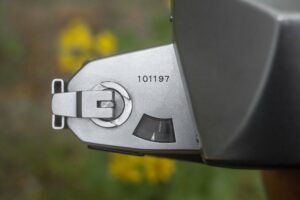
To the right of the prism is the large diameter shutter speed dial which has both the ASA film speed setting and a very cool coupled aperture display in the center. The shutter speed dial turns with prominent click stops from B all the way to 2000. There is a stop between Bulb and the highest speed, so you cannot go from one directly to another. A small window displaying the selected film speeds is in between the setting for 1 second and Bulb and is changed by rotating a thin metal ring in between the shutter speed and aperture settings. Film speeds from ASA 10 to 800 are possible.

The coupled aperture scale is not used for selecting an f/stop, but acts as a duplicate display of what f/stop you’ve selected on the lens. This allows you to quickly see both your selected shutter speed and f/stop side by side without having to move your eye to the lens. As you change f/stops on the lens, an arm behind the lens not only lets the meter know to compensate for the larger or smaller diaphragm, but it also causes this wheel to turn. It’s a feature that’s really not necessary, but super cool to see in action.
Tightly wrapped around the shutter speed dial is the long arm of the rapid film advance lever. The lever has an approximate 30 degree offset and an additional 180 degree swing to advance the film one full exposure. Although this is not a long throw, the Konica F does support multiple short strokes of the film advance lever if you prefer to do it with smaller motions. The shutter release in the center of the film advance lever’s axis and is threaded for a cable release. This location of the shutter release is one of the few ergonomic flaws of the camera as I find it to be too close to the edge of the camera. For such a large and heavy SLR, I feel like where I have to move my finger to locate it requires me to bend my finger too far. A location in the center of the shutter speed dial, or on the front face of the camera like a Miranda would have been a more comfortable location in my opinion.
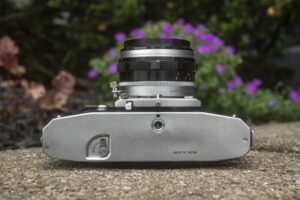
The base of the camera has a centrally located 1/4″ tripod socket and the rewind release used for disconnecting the film transport at the end of a roll of film. Unlike most cameras that rely on a button, the Konica F has a small lever that must be moved a full 90 degrees until it locks into position to rewind film. When done rewinding, moving the film advance lever will automatically release it. Also from the bottom of the camera, we get a good look at the lens release lever and depth of field preview levers, which I’ll explain later.
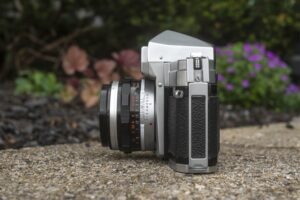
Of the Konica’s two sides, the left is more interesting with both the sliding film door release latch and a small shoe for holding a flash bracket. Like most cameras with interchangeable lenses, the prism does not have any sort of flash shoe, so the only way to mount a flash to the camera was via a bracket made specifically for this camera. Both sides of the camera have forward angled metal strap lugs, which is a very good thing as this camera’s left would definitely require a good neck strap!
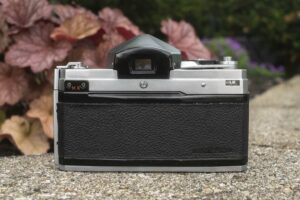
Around back we see the rectangular eyepiece which is surrounded by a large black plastic frame which doesn’t appear to have any purpose, but it sure does look good. Below the eyepiece is a circular button which is used to release the prism for removal. In the upper left corner are two flash ports for M and X synchronization. The Konica F can sync with bulbs up to it’s maximum 1/2000 shutter speed and would have been one of the first cameras ever made with an X-sync speed of 1/125 courtesy of it’s new Hi Synchro vertically traveling shutter. In the upper right corner is the automatic resetting exposure counter. One last interesting thing on the back of the camera is a prominent hump in the center of the door, which is there to make room for the movable film pressure plate feature of the camera.
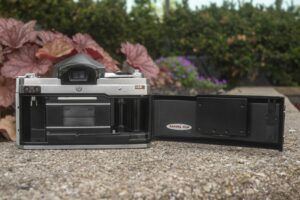
With the sliding latch on the camera’s left side unlocked, the right hinged door swings open to reveal the film compartment. Film transports from left to right onto a fixed and multi-slotted metal take up spool. Loading film is pretty easy in the Konica F as you have multiple places to attach the leader. Once it’s in one of the slots, wind the camera twice and insert the cassette into the chamber on the left.
There are two very interesting things to see in the Konica F film compartment. The first are the shutter curtains. A twin blade design, the Konishiroku Hi Synchro looks like no other shutter I’ve seen. Each of the two pieces of the shutter curtain appear to be very thick, with a stepped ridge going right through the middle. If there was any doubt that the Hi-Synchro was not the same as the Copal Square, all you have to do is look at it. Advancing the film cocks the shutter similar to how other vertically traveling shutters do. The construction is completely different, but the principle is the same.
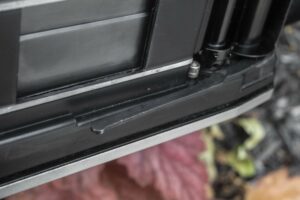
The second unique feature in the Konica F is a feature borrowed from the Koni-Omega Rapid press cameras, in which a lever below the film gate pushes the film pressure plate away from the film gate as the advance lever is in use. The idea behind this was by taking pressure off the film while advancing film would not only prevent any scratches from the film rubbing against the pressure plate, but also that it would decrease resistance, making film transport smoother. This feature would not appear on any other SLR made by Konica or anyone else, so I presume it was found that it didn’t have much of a positive effect, and likely increased complexity in the camera, but it sure is cool.
The pressure plate itself is a rather large rectangle with a grid of divots which for most cameras, was there to decrease resistance, but seem redundant here. There is a small clip on the edge of the inside of the door that helps hold the cassette still while inserted into the camera. The Konica F predates the use of foam light seals, so inside the film compartment are seals made out of yarn in the two door channels, and a black piece of felt in front of the hinge which on this particular example, were still in tact, protecting the film compartment from light leaks.
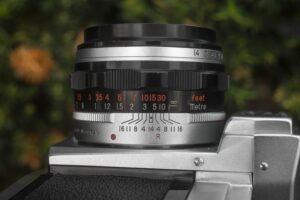
The location of the selenium meter directly in front of the prism results in a slight overhang of the camera over the top of the lens, so unlike most SLRs, part of the lens is obscured by the meter. As a result, a depth of field scale and the index mark for the focus ring is offset to the left of the lens when looking down upon it. If you wish to read your focus distances (instead of just focusing through the viewfinder), you need to tilt the camera to the side to read the scale.
Thankfully, the meter does not obscure the diaphragm scale near the front of the lens. Black numbers engraved into a chrome ring show f/stops from f/1.4 to f/16 using the 52mm lens I have mounted to the camera. Controlling the diaphragm is not done directly from this ring however, instead a coupled lever to the right of the lens (while looking down upon it) is used to change f/stops. Moving the diaphragm control lever not only rotates the chrome aperture ring, but it also rotates the coupled aperture scale in the center of the shutter speed dial on top of the camera.
The viewfinder is predictably basic for a 1960s SLR. There is no meter display or anything showing selected shutter speeds or f/stops. The focusing screen has a visible Fresnel pattern extending from both a split image focus aide and ground glass circle in the center. The design of the split image makes focusing in less than ideal light very easy. The viewfinder itself is sufficiently bright for a camera of its era, but understandably does not compare to SLRs from decades later. There certainly is nothing to gripe about with the Konica F’s viewfinder, but considering the company was so willing to innovate with a state of the art vertically traveling shutter with top 1/2000 speed, a moving film pressure plate, and in body coupled meter, it is a little disappointing that none of that innovation made it into the viewfinder. Despite the Konica F’s many strengths, with it to your eye, it looks like any other SLR of its era.
The Konica F certainly is a beautiful camera with some cool features. As a first effort from Konishiroku, I strongly feel the camera’s strengths greatly outweigh its weaknesses. Handling the camera and you can’t help but share in the excitement photographers might have had when it first debuted in 1960. But of course, this is a camera, and it needs to make photographs, so pros and cons aside, what is it like to shoot? Keep reading…
My Results
Having the chance to see, or even hold a camera like the Konica F is a special opportunity. For most people, simply handling a rare camera is all you could ask for. Certainly something made in such low numbers and as hard to find as the Konica F isn’t something you should attempt to actually use though, is it? Most collectors would be happy to put this under a glass bubble on their shelf, but I am not most collectors. If I have access to a camera and it works, I want to shoot it. So upon confirming the shutter on the Konica was working, I shot two rolls of film, the first was bulk Kodak TMax 100, and the second, a ~20 year expired roll of AGFA Vista 100.
Released in 1960, the Konica F was the company’s first 35mm SLR, but it was not the company’s first camera, as many Konica, Konishiroku, and Rokuoh-sha cameras predated it by decades. Attached to most of those cameras were one of many excellent Hexanon and Hexar lenses. Like other A-list Japanese lens makers, Konica lenses are highly regarded for their optical performance, and the 7-element 52mm f/1.4 Konishiroku Hexanon was no exception. In addition to its construction, this lens has an amazingly vibrant blue coating to it, unlike most other lenses of it’s era which when found today have yellowed. Point the lens at the sky and the lens glows a glorious blue that I assure you is not Photoshopped.
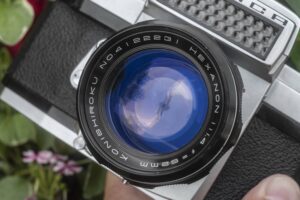
Sharpness was excellent corner to corner, across the entire image. Vignetting and edge softness was not evident in any of the images I shot, even the lower light ones like the mirror selfie in which darkened corners easily creep in. The images shot on Kodak TMax 100 showed excellent contrast, but I did note that I ended to overexpose the black and white shots a bit. The expired AGFA Vista handled most scenes well but tended to overexpose bright skies. Colors were muted as much as you’d expect 20 year expired color film, but were still fairly accurate.
Overall, the images produced by this lens were as good as any from the era. The one and only con to this lens is that Konica’s original F-mount is not the same as the later, and much more common AR-mount so for users of later Konica SLRs, the lenses cannot be easily swapped, nor adapted to digital.
Handling the Konica F is a mostly positive experience, but it is not perfect as Konishiroku made some curious design decisions which I’ll get to in a moment, but first the good.
The camera is large and heavy, like any late 50s/early 60s SLR should be. The stepped sides of the camera conformed to my hands quite well, helping somewhat mask the heavy weight of the camera. I found that the size of the camera was perfect for me, neither too big, nor too small. The viewfinder, although not as bright as SLRs made in the decades to come, is very bright and usable compared to lesser cameras of its era. The film advance lever is exactly where you expect it to be and the motion to advance the film before each shot is smooth and easily done in a single stroke.
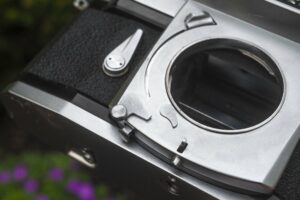
The aperture control lever, located on the side of the lens near your right hand is comfortably located and allows for easy changes of f/stops on the lens. The design of the aperture linkage was a necessity to couple the camera to the meter, but with there only being a top plate match needle, I feel like Konica missed the opportunity to have the match needle visible in the viewfinder so that you could easily control exposure with your right hand with the camera to your eye. As it is, you still have to lower the camera to read the match needle, somewhat negating the benefit of an easy to reach aperture control lever. Similarly, the very large shutter speed knob is very easy to turn with your right index finger with the camera to your eye, but there’s no need as you still need to lower the camera from your eye to take an exposure reading. Perhaps Konica had planned a second Konica F model that would have a viewfinder match needle that could have taken advantage of the easy to use shutter speed dial and aperture lever.
Where the ergonomics start to fall apart is with the location of the shutter release in the axial center of the film advance lever. It is not unusual to have a camera with the shutter release in this location, but the large size and heavy weight of the Konica F requires you to contort your right index finger into an uncomfortable position to locate it, while still maintaining a secure grip on the camera. I feel as though a shutter release in the center of the shutter speed dial or even on the front of the camera would have been a much more comfortable locaiton, allowing you to securely hold the camera while pressing the shutter release.
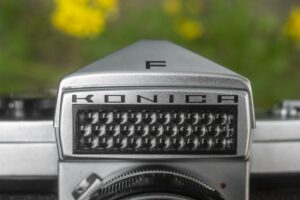
Another snafu is the result of the large selenium meter in front of the prism which overhangs the front of the lens. This means that had the aperture and focus scale been located at the top of the lens like on most SLRs, you wouldn’t be able to see it. Thankfully, Konishiroku realized this and moved both scales off to the side of the lens, which is not blocked by the meter, but has the side effect of requiring you to rotate the camera nearly 90 degrees any time you want to see the scale. This is a minor annoyance, but is still worth mentioning as it takes away from a foolproof operation you might expect from a world class camera.
The Konica F is a very attractive camera and in my opinion is on par with the nicest looking Miranda SLRs of the same era, beating out the utilitarian look of early Nikon, Canon, and Minolta SLRs, but it is clear this was a first attempt for Konishiroku. Ergonomic snafus aside, the lens mount was very poorly thought out, a problem the company quickly realized as they replaced it barely 6 years after its release. Its small size would have caused issues with faster and wider angle lenses, similar to problems with the Ihagee Exakta mount, the external coupling for aperture control causes mounting and dismounting the lens to be more difficult than it needs to be, and with so many parts, is begging for failure over time. In addition, if this was intended to be a pro-level SLR that could compete with the Nikon Reflex, it’s lack of any motor drive couplings was another missed opportunity.
The moving film pressure plate was a neat idea, but was a solution to a problem that nobody asked for as literally no other 35mm SLR ever made had that feature and no one ever had an issue with scratched film. It’s inclusion seems harmless, however it just added additional complexity to an already complex and expensive camera. The designers at Konishiroku had some great ideas, but clearly invested their R&D time and money into the wrong features.
Overall, the Konica F is a very cool camera and one I very much enjoyed shooting. I didn’t love the position of the shutter release, but the camera handled pretty nicely. The lens mount made swapping lenses a chore, but since I only had access to the one lens, this was hardly an issue. The viewfinder was as good as anything out there, and of course the 7-element Hexanon lens delivered superb results. This is an attractive, historically significant, and rare camera that is worthwhile to be added to any serious collection, just be prepared to wait a long time to find one, and when you do, open up that wallet wide!
Related Posts You Might Enjoy
External Links
http://camera-wiki.org/wiki/Konica_F
http://www.konicafiles.com/7-other-konica-cameras/-the-konica-f-1960/


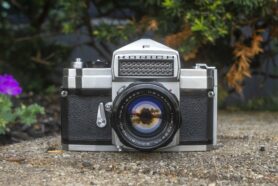
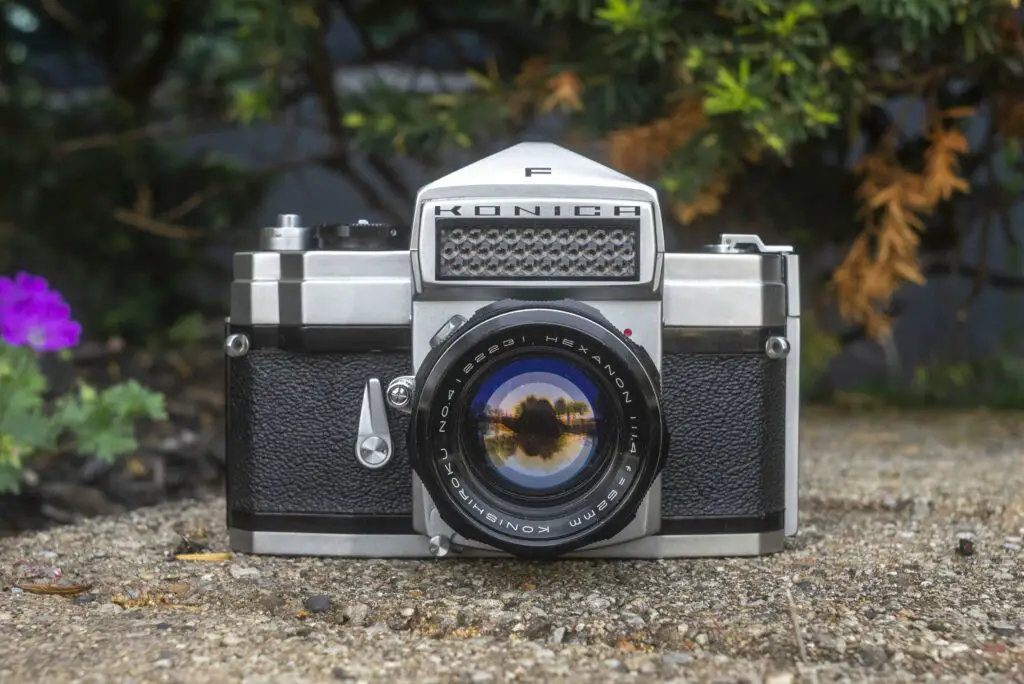
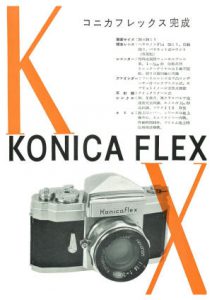
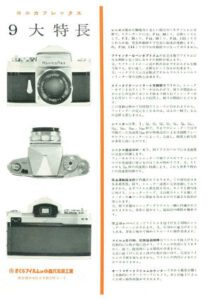
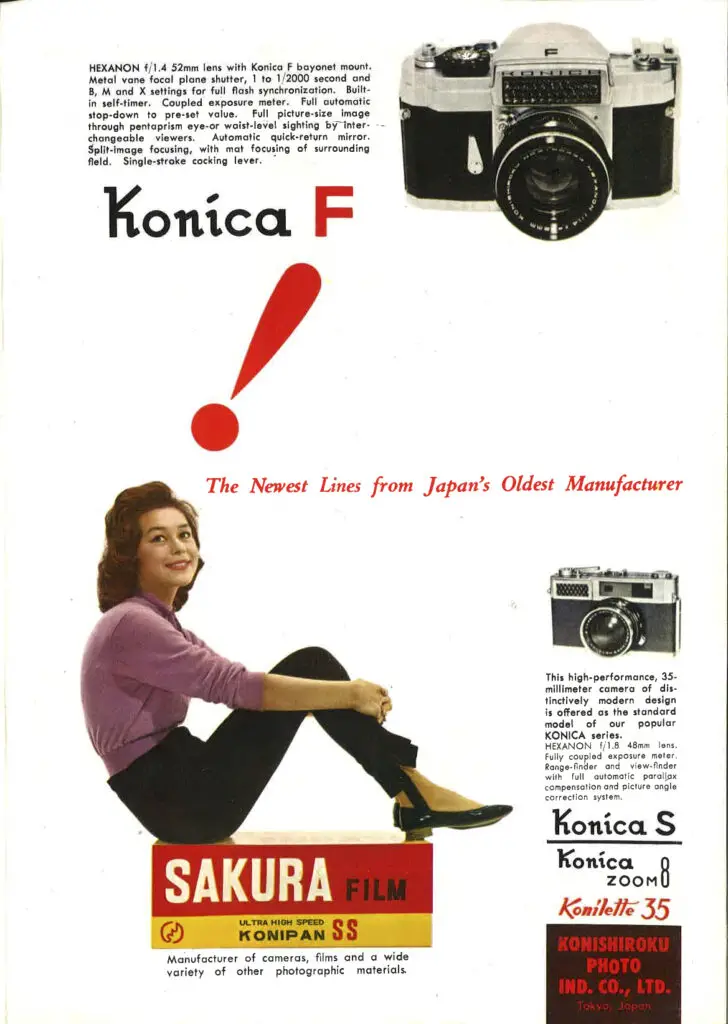
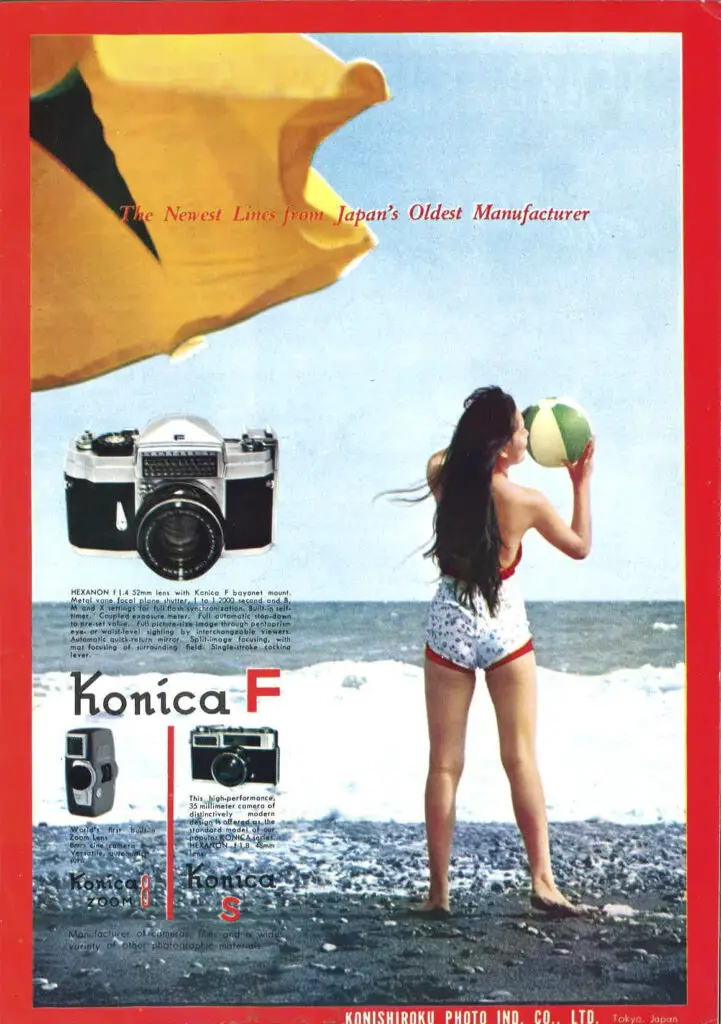
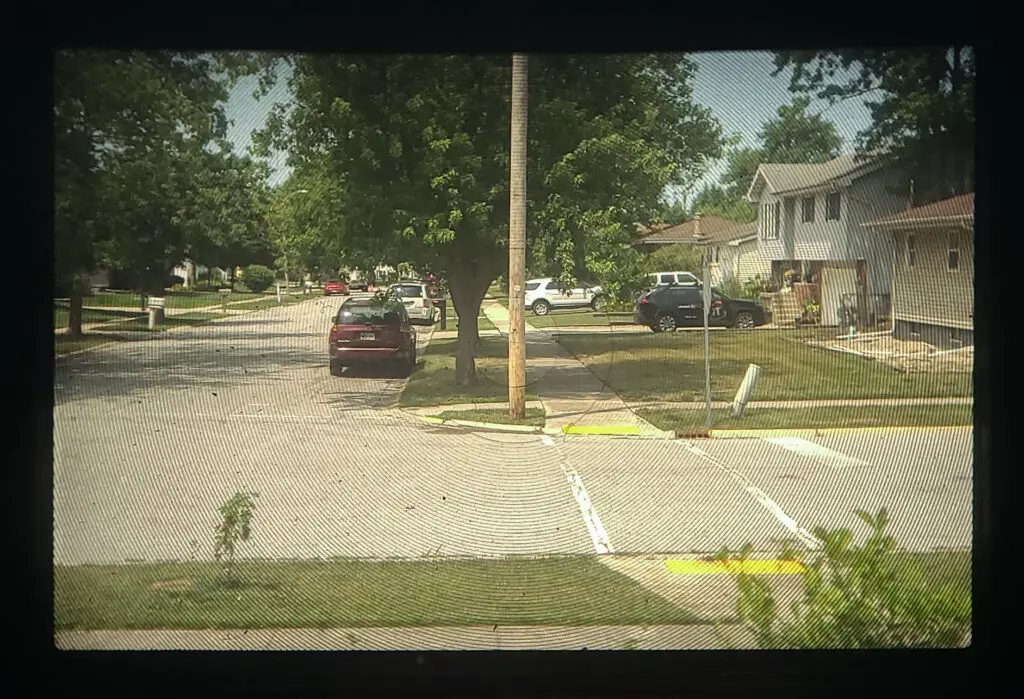
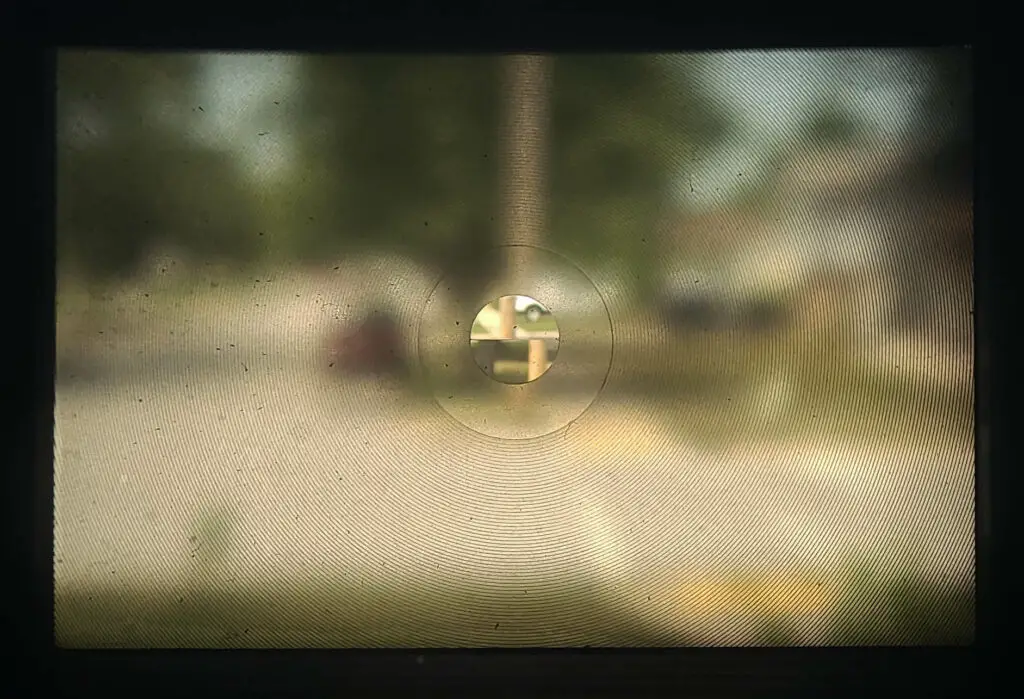


























Finally we get to read a proper review of this worthy vintage beast of a camera! Does the lens aperture stopdown linkage connect the body to the lens via an external widget coupling at the bottom of the lens – as on the FS? In my humble opinion based on shooting FS models, that’s a poor design, with a good likelihood of damage when lenses are being changed, or the body stored with no lens mounted.
Thanks Roger! Yep that little linkage is still there on the F, just like the FS. The F has an additional coupling for the aperture lever which works similarly to the one that Miranda used. As much as I like this camera, Konishiroku definitely missed the boat with the lens mount they gave it.